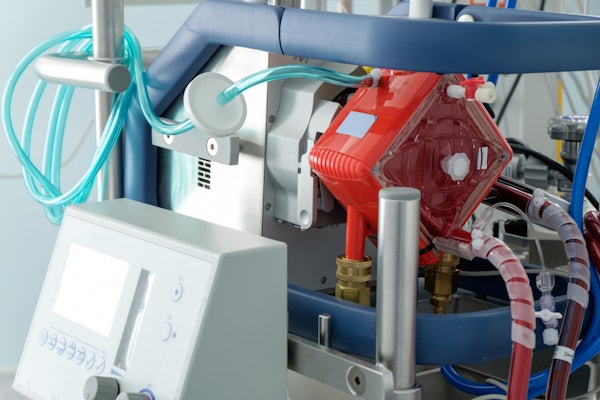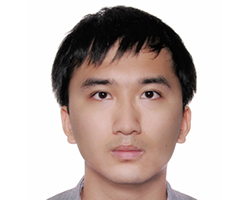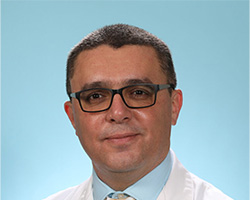Artificial intelligence may assist decisions on which patients should get critical life support
McKelvey Engineering, School of Medicine team develop machine-learning model using COVID-19 patient data

Extracorporeal membrane oxygenation, or ECMO, is a method used in critical care situations to pump blood outside of the body to a machine that removes carbon dioxide and sends oxygenated blood back into the body’s tissues. The intensive life-support method was used as a last resort during the COVID-19 pandemic to treat the sickest patients in cardiopulmonary failure. Because demand far exceeded its extremely limited availability, clinicians had difficulty choosing which patients would have the best outcomes from the treatment.
An interdisciplinary team of researchers at Washington University in St. Louis has developed a new machine-learning model to assist clinicians in making this decision. Chenyang Lu, the Fullgraf Professor in the McKelvey School of Engineering, professor of medicine in the School of Medicine and senior author; and Bing Xue, a doctoral student in his lab, presented the findings at the Association for Computer Machinery Knowledge Discovery and Data Mining (ACM SIGKDD) Conference Aug. 6-10, 2023.
During the height of the pandemic, fewer than 1% of critically ill COVID-19 patients received ECMO treatment due to its limited availability. Of more than 14,000 COVID-19 patients who received ECMO treatment, more than half survived. However, nearly 90% of those who were waiting for treatment at an ECMO center died while waiting. These patients had a median age of 40 and had been otherwise healthy prior to contracting COVID-19.
Because there is little guidance on which patients should get ECMO, the team developed the Treatment Variational AutoEncoder (TVAE), a model designed to predict individual treatment effect. To validate the model, they used two datasets of COVID-19 patients in intensive care units: one an international data set from more than 1,500 hospitals in 63 countries, and the other from 15 BJC HealthCare hospitals. The datasets included whether the patient received the ECMO treatment or not, whether the patient died or survived, and hundreds of pieces of data from the patient’s electronic health record, such as height, weight and age. To train the model, these data were transformed to a low-dimensional representation in what is called latent encoding that preserves the inherent relationship among the data while reducing redundancy.
Once they gave the data to the TVAE, they discovered relationship patterns in the complex data, which allowed them to predict the most likely treatment decision as well as the outcomes with and without treatment.
“First, we needed to model the probability of getting treatment for each patient, reflecting the underlying treatment assignment policy and the associated risks, considering there is a risk of death from ECMO,” Lu said. “Next, we estimated the impact of each treatment decision, calculated by the survival or death difference with or without treatment.”
“Clinicians would like to give the ECMO treatment to someone more likely to survive if they receive the treatment,” said Xue, first author of the paper. “They want to know if the patients who are assigned are indeed the patients that should be assigned. Individual treatment effect estimation is challenging because we do not know the ‘counterfactual’ outcomes in historical clinical data. For example, for a previous patient who received treatment, we don’t know if they would have survived without the treatment.”
“Learning treatment effect is further complicated by the fact that ECMO was only given to high-risk patients with severe symptoms,” Lu said. “This means that the patients who received ECMO support have different characteristics from those who did not, preventing a direct comparison between the two groups of patients.”
“We found that such heterogeneity among treatment groups can be expressed by the patients’ latent encoding, so we isolate their group difference from their common characteristics and utilize such difference in treatment analysis,” Xue said. “In addition, the model exploits its generative capability to augment the imbalanced dataset.”
The TVAE model is designed to analyze clinical data with all these challenges and make accurate predictions of the individual treatment effect, Lu said.
“Our TVAE outperforms state-of-the-art treatment effect models in predicting ECMO treatment assignment as well as factual responses, with or without ECMO, validated by two large real-world COVID-19 datasets,” Lu said. “While this work is motivated by and evaluated in the context of ECMO treatment, the proposed approach may be generalized for other treatment estimation tasks facing similar challenges.”
Ahmed Said, MD, PhD, assistant professor of pediatrics at the School of Medicine and an author on the paper, said the TVAE model is likely the first of its kind to address the difficult ECMO decision-making process clinicians face.
“To date, all the available literature has been limited to outcomes of only patients supported on ECMO without a true propensity matched control group to compare outcomes with,” he said. “The current TVAE model addresses this issue by taking a two-stage approach: treatment allocation (patients who did and those who did not receive ECMO support) and then treatment effects (survival outcomes for those who received and those who did not receive ECMO). Once further validated on different ECMO cohorts, this model has the potential to inform the development of clinical decision support tools that could provide clinicians with actionable evidence to truly guide real-time decision making.”
Xue B, Said A, Xu Z, Liu H, Shah N, Yang A, Payne P, Lu C, ISARIC Clinical Characterisation Group. Assisting clinical decisions for scarcely available treatment via disentangled latent representation. Presented at Association for Computer Machinery Knowledge Discovery and Data Mining (ACM SIGKDD) Conference, Aug. 6-10, 2023. DOI: https://doi.org/10.1145/3580305.3599774
This research was supported by the Fullgraf Foundation and the Big Ideas 2020 COVID Grant through the BJC Healthcare and Washington University School of Medicine in St. Louis.
The code is publicly available at https://github.com/xuebing1234/tvae.






